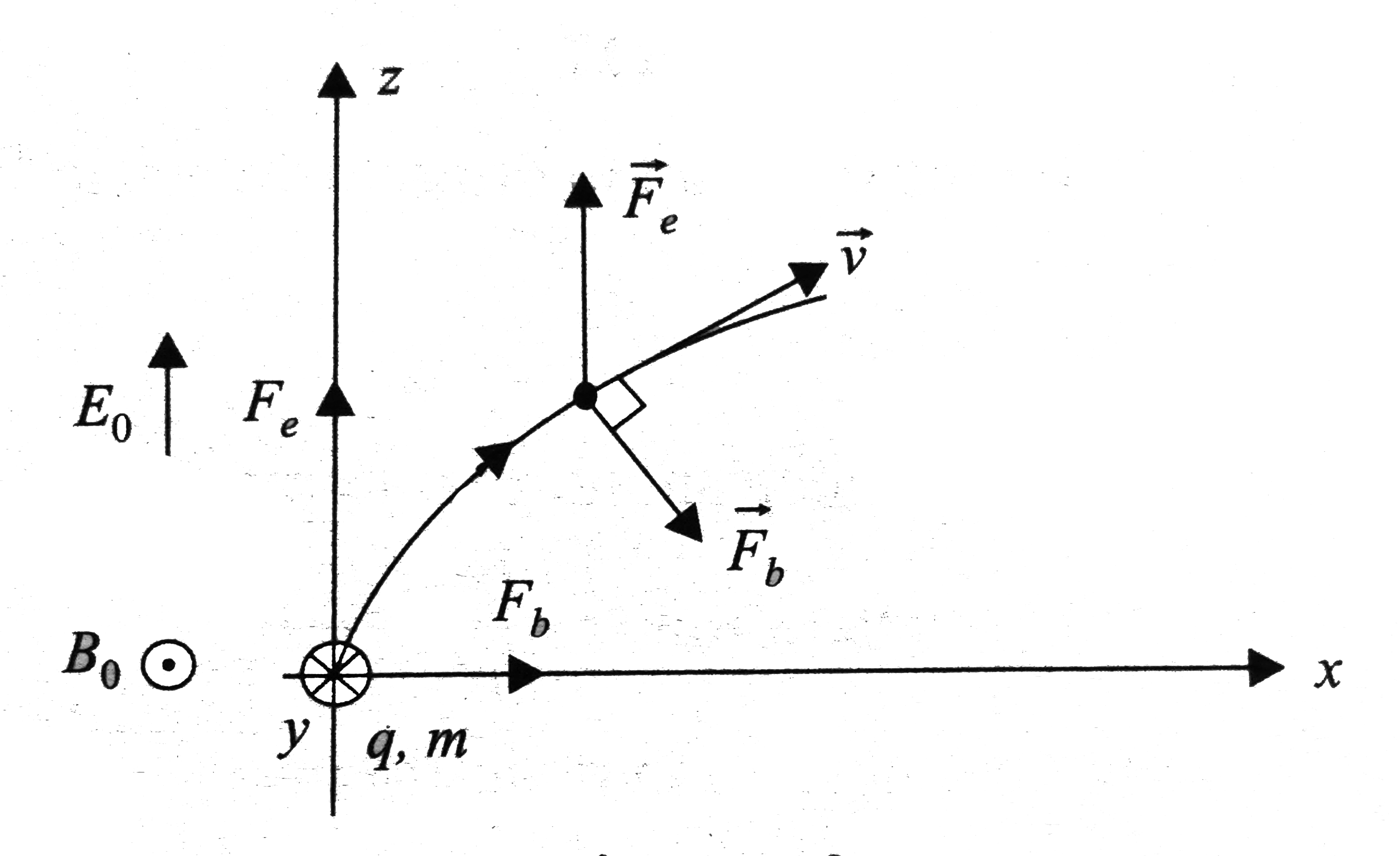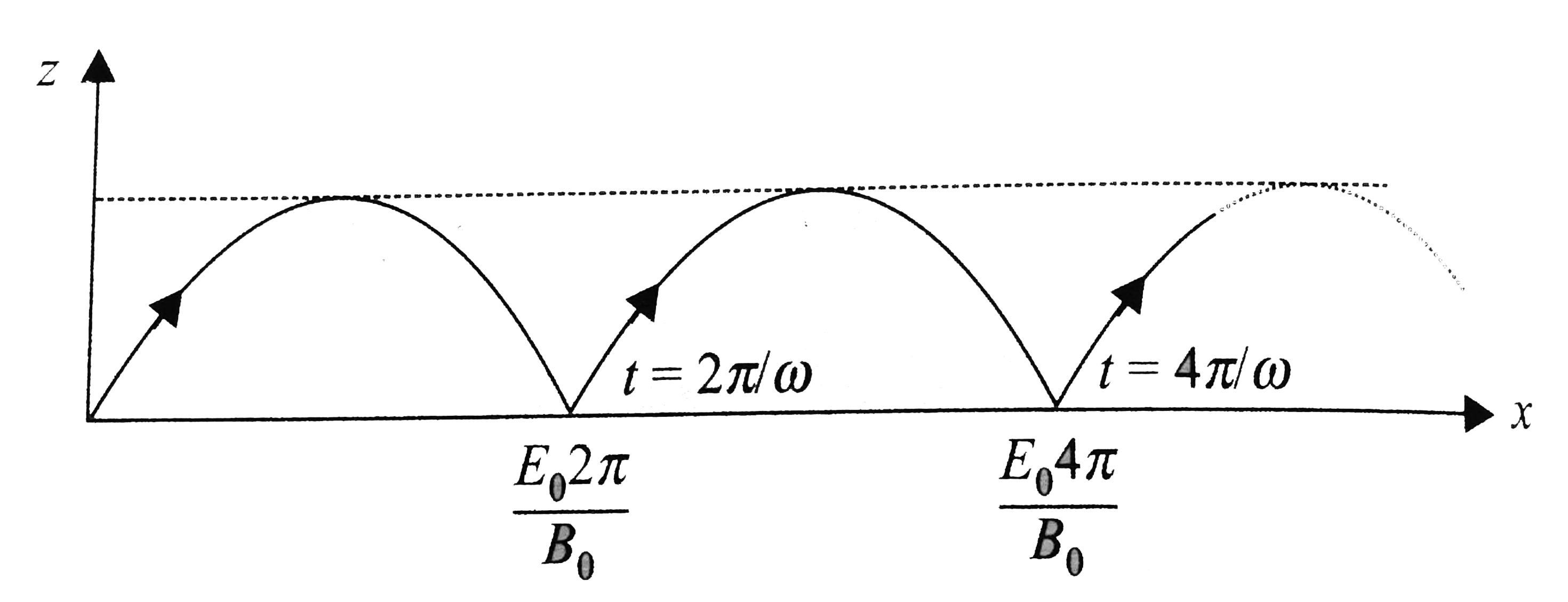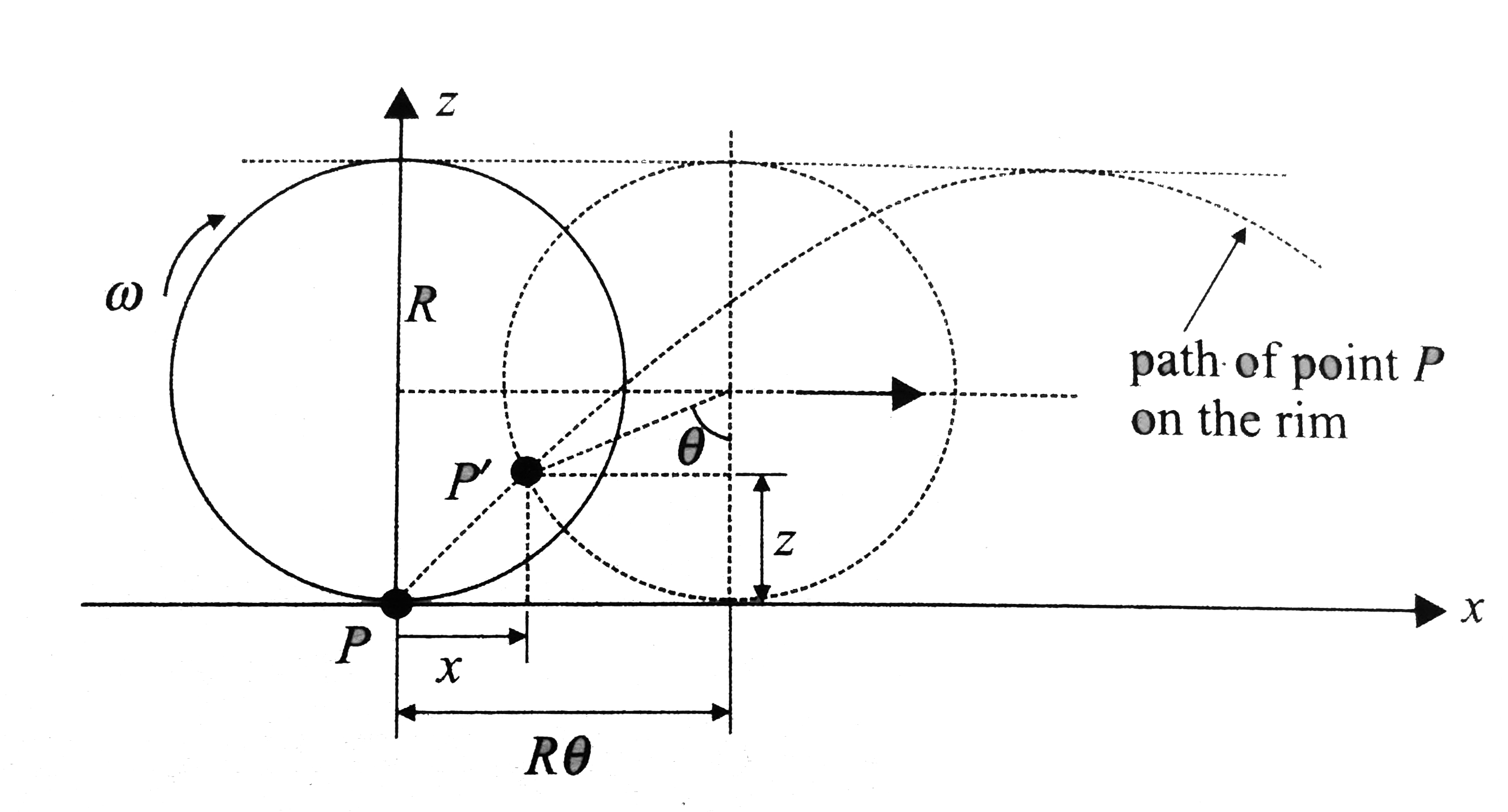A particle having mass m and charge q is released from the origin in a region in which electric field and megnetic field are given by →B=−B0ˆj and →E=→E0ˆk. Find the speed of the particle as a function of its z-coordinate.
In Fig shown B0 is outward. As soon as we release the
particle at origin. Electric field will apply force Fe=qE0 on the
particle. Due to this force, the charge particle will gain accelera-
tion and hence velocity along z-axis. And as it gains velocity
along z-axis, then magnetic field will apply the force Fb on charge particle. Now both the forces are always in x-z plane, so
path of charge will be in x-z plane as shown. Let at any time its
velocity is →v=vxˆi+vzˆk. Let →a=axˆi+azˆk is the acceleration
at any time.

Then →F≠t=m→a
⇒qE0ˆk−q(vxˆi+vzˆk)×B0ˆj=m(axˆi+azˆk)
⇒qE0ˆk−qvxB0ˆk+qvzB0ˆi=m(axˆi+azˆk)
⇒max=qvzB0andmaz=q(E0−vxB0)...(i)
⇒mdvxdt=qvzB0andmdvzdt=q(E0−vxB0)...(ii)
From Eq. (ii), dvzdt=qm(E0−vxB0)⇒d2vzdt2=−qB0mdvxdt
⇒d2vzdt2=−qB0mqB0mvz=−(qB0m)2vz
Solution of the above equation is : vz=vz0sin(ωt+ϕ).....(iii)
(where ω=qB0m)
Puting at t=0,vz=0,we≥tϕ=0
Differentiating Eq. (iii),
dvzdt=vz0ωcos(ωt+ϕ)⇒az=ωvz0cosωt
at t=0,az=Fem=qE0m
⇒qE0m=qB0mvz0cos0∘⇒vz0=E0B0
So Eq. (iii) can be written as : vz=E0B0sin(ωt)....(iv)
Puting the value of vz in Eq. (ii), mdvxdt=qE0B0(sinωt)B0
⇒∫v0dvx=∫t0qE0msinωtdt⇒vx=qE0mω[1−cosωt]
⇒vx=qE0m(qB0)/m[1−cosωt]⇒vx=E0B0[1−cosωt]....(v)
Equations (iv) and (v) give velocity as a function of time.
From Eq.(v), dxdt=E0B0(1−cosωt)
⇒∫x0ds=E0B0∫t0(1−cosωt)dt
⇒x=E0ωB0[ωt−sinωt]....(vi)
From Eq.(iv)
dzdt=E0B0sinωt⇒∫z0dz=E0B0∫t0sinωtdt
⇒z=E0ωB0[1−cosωt]....(vii)
Equations (vi) and (vii) give the path of the verticle.
We see that at t=2π
x=E0B02π,z=0

This path is known as cycloided path. This is the same kind of path as followed by a point on the rim of a purely rolling wheel, which is expalined as below.
Let a wheel is rolling purely with angular velocity ω as shown.
Let at t=0, a point P on the rim is at the bottom-most position of
the wheel. After time t, the wheel turns by an angle θ as shown
and point P comes at point P'. Let us find the coordinates of P'.

x=Rθ−Rsinθ=Rωt−Rsinωt=R[ωt−sinωt]...(viii)
z=R−Rcosθ=R[1−cosωt]....(ix)
Equations (viii) and (ix) resemble Eqs (vi) and (vii).
Hence, the resulting path followed by charge is cycloidal.
(b) To find velocity as function of z-coordinate.
From equations (iv) and (v)
v=√v2x+v2z=E0B0√(1−cosωt)2+(sinωt)2
=E0B0√(1−cosωt)2+(1−cosωt)(1+cosωt)
=E0B0√1−cosωt2=E0B0√zωB0E02[FromEq.(vii)]
=
⎷E20B20zqB0mB0E02=√2qE0Zm
Alternate Method to find velocity: Since the magnetic field does
not perform any work, therefore, whatever has been the gain in
kinetic energy it is only because of the work done by electric
field. Applying work-energy theoram, WE=ΔK
⇒qE0z=12mv2−0orv=√2qE0Zm
Topper's Solved these Questions
- MAGNETIC FIELD AND MAGNETIC FORCESBook:CENGAGE PHYSICSChapter:MAGNETIC FIELD AND MAGNETIC FORCESExercise:Exercise 1.1
Explore 22 Videos
- MAGNETIC FIELD AND MAGNETIC FORCESBook:CENGAGE PHYSICSChapter:MAGNETIC FIELD AND MAGNETIC FORCESExercise:Exercise 1.2
Explore 13 Videos
- MAGNETIC FIELD AND MAGNETIC FORCESBook:CENGAGE PHYSICSChapter:MAGNETIC FIELD AND MAGNETIC FORCESExercise:Multiple Correct Answer type
Explore 2 Videos
- KINETIC THEORYBook:CENGAGE PHYSICSChapter:KINETIC THEORYExercise:Question Bank
Explore 31 Videos
- Magnetism and MatterBook:CENGAGE PHYSICSChapter:Magnetism and MatterExercise:Question Bank
Explore 50 Videos
Similar Questions
A particle having mass m and charge q is released from the origin in a region in which electric field and magnetic field are ginen by
B=+B0ˆj and →E=+E0ˆi.
Find the speed of the particle as a function of its X-coordinate.
View SolutionA particle having mass m and charge q is released from the origin in a region in which electric field and magnetic field are given by
→B=−B0→Jand→E=E0→K.
Find the speed of the particle as a function of its z-coordinate.
View Solution
Knowledge Check
A charged particle of mass m and charge q is projected on a rough horizontal XY plane. Both electric and magnetic fields are given by →E=−10ˆkN/C and magnetic field →B=−5→k tesla are present in the region. The particle enters into the magnetic field at (4,0,0)m with a velocity 50→jm/sec. The particle starts into a curved path on the plane. If coefficietn of friction μ=13 between particle and plane, then (qE=2mg,g=10m/s2).
Total work done by electric force on the particle isA250JBzeroC125JDnoneA charged particle of mass m and charge q is projected on a rough horizontal XY plane. Both electric and magnetic fields are given by →E=−10ˆkN/C and magnetic field →B=−5→k tesla are present in the region. The particle enters into the magnetic field at (4,0,0)m with a velocity 50→jm/sec. The particle starts into a curved path on the plane. If coefficietn of friction μ=13 between particle and plane, then (qE=2mg,g=10m/s2).
The time after which particle comes to rest, isA5sB4sC3sD1sMagnetic force on a charged particle is given by →Fm=q(→v×→B) and electrostatic force →Fe=q→E. A particle having charge q = 1C and mass 1 kg is released from rest at origin. There are electric and magnetic field given by →E=(10ˆi)N/Cforx=1.8m and →B=−(5ˆk)T for 1.8m≤x≤2.4m
A screen is placed parallel to y-z plane at x=3m. Neglect gravity forces.
The speed with which the particle will collide the screen isA3ms−1B6m/s−1C9 m//s^(-1)D12m/s−1
A particle having mass m and charge q is released from the origin in a region in which ele field and magnetic field are given by B=−B0ˆjand E=E0ˆk.
Find the y- component of the velocity and the speed of the particle as a function of it z-coordinate.
View SolutionA particle of charge q and mass m released from origin with velocity →v=v0ˆi into a region of uniform electric and magnetic fields parallel to y-axis. i.e., →E=E0ˆjand→B=B0ˆj. Find out the position of the particle as a functions of time
Strategy : Here →E∣∣→B
The electric field accelerates the particle in y-direction i.e., component of velocity goes on increasing with acceleration
ay=Fym=Fem=qE0m
The magnetic field rotates the particle in a circle in x-z plane (perpendicular to magnetic field) The resultant path of the particle is a helix with increasing pitch.
Velocity of the particle at time t would be
→v(t)=vxˆi+vyˆj+vzˆk
View SolutionMagnetic force on a charged particle is given by →Fm=q(→v×→B) and electrostatic force →Fe=q→E. A particle having charge q = 1C and mass 1 kg is released from rest at origin. There are electric and magnetic field given by →E=(10ˆi)N/Cforx=1.8m and →B=−(5ˆk)T for 1.8m≤x≤2.4m
A screen is placed parallel to y-z plane at x=3m. Neglect gravity forces.
y-coordinate of particle where it collides with screen (in meters) is
View SolutionMagnetic force on a charged particle is given by →Fm=q(→v×→B) and electrostatic force →Fe=q→E. A particle having charge q = 1C and mass 1 kg is released from rest at origin. There are electric and magnetic field given by →E=(10ˆi)N/Cforx=1.8m and →B=−(5ˆk)T for 1.8m≤x≤2.4m
A screen is placed parallel to y-z plane at x=3m. Neglect gravity forces.
Time after which the particle will collide the screen is (in seconds)
View SolutionA particle of charge q and mass m starts moving from the origin under the action of an electric field →E=E0ˆiand→B=B0ˆi with a velocity →v=v0ˆj. The speed of the particle will become 2v0 after a time.
View Solution